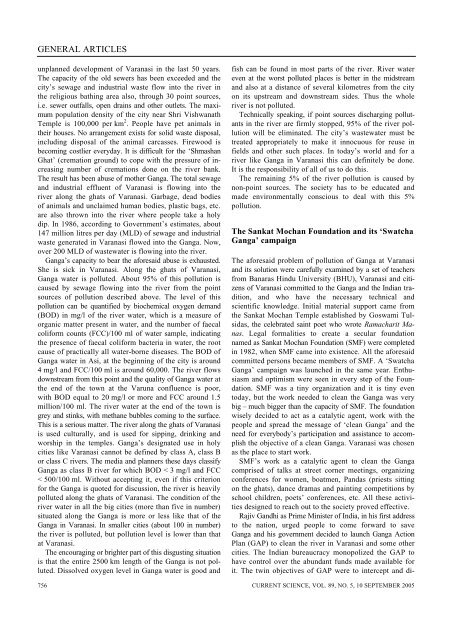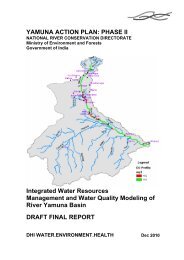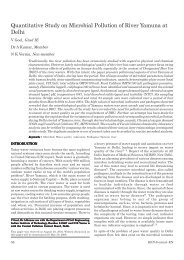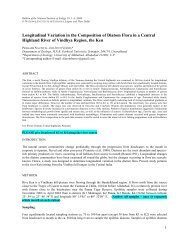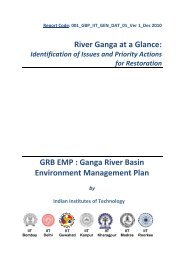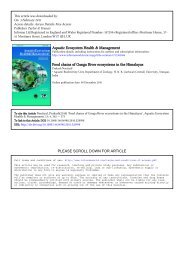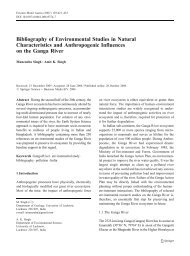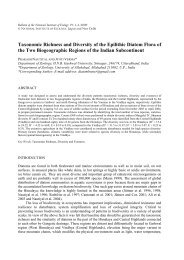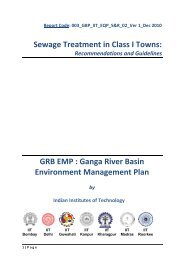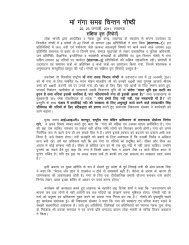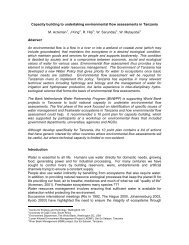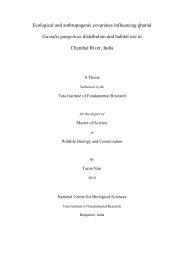The Ganga at Varanasi and a travail to stop her abuse - GANGAPEDIA
The Ganga at Varanasi and a travail to stop her abuse - GANGAPEDIA
The Ganga at Varanasi and a travail to stop her abuse - GANGAPEDIA
Create successful ePaper yourself
Turn your PDF publications into a flip-book with our unique Google optimized e-Paper software.
GENERAL ARTICLES<br />
unplanned development of <strong>Varanasi</strong> in the last 50 years.<br />
<strong>The</strong> capacity of the old sewers has been exceeded <strong>and</strong> the<br />
city’s sewage <strong>and</strong> industrial waste flow in<strong>to</strong> the river in<br />
the religious b<strong>at</strong>hing area also, through 30 point sources,<br />
i.e. sewer outfalls, open drains <strong>and</strong> ot<strong>her</strong> outlets. <strong>The</strong> maximum<br />
popul<strong>at</strong>ion density of the city near Shri Vishwan<strong>at</strong>h<br />
Temple is 100,000 per km 2 . People have pet animals in<br />
their houses. No arrangement exists for solid waste disposal,<br />
including disposal of the animal carcasses. Firewood is<br />
becoming costlier everyday. It is difficult for the ‘Shmashan<br />
Gh<strong>at</strong>’ (crem<strong>at</strong>ion ground) <strong>to</strong> cope with the pressure of increasing<br />
number of crem<strong>at</strong>ions done on the river bank.<br />
<strong>The</strong> result has been <strong>abuse</strong> of mot<strong>her</strong> <strong>Ganga</strong>. <strong>The</strong> <strong>to</strong>tal sewage<br />
<strong>and</strong> industrial effluent of <strong>Varanasi</strong> is flowing in<strong>to</strong> the<br />
river along the gh<strong>at</strong>s of <strong>Varanasi</strong>. Garbage, dead bodies<br />
of animals <strong>and</strong> unclaimed human bodies, plastic bags, etc.<br />
are also thrown in<strong>to</strong> the river w<strong>her</strong>e people take a holy<br />
dip. In 1986, according <strong>to</strong> Government’s estim<strong>at</strong>es, about<br />
147 million litres per day (MLD) of sewage <strong>and</strong> industrial<br />
waste gener<strong>at</strong>ed in <strong>Varanasi</strong> flowed in<strong>to</strong> the <strong>Ganga</strong>. Now,<br />
over 200 MLD of wastew<strong>at</strong>er is flowing in<strong>to</strong> the river.<br />
<strong>Ganga</strong>’s capacity <strong>to</strong> bear the aforesaid <strong>abuse</strong> is exhausted.<br />
She is sick in <strong>Varanasi</strong>. Along the gh<strong>at</strong>s of <strong>Varanasi</strong>,<br />
<strong>Ganga</strong> w<strong>at</strong>er is polluted. About 95% of this pollution is<br />
caused by sewage flowing in<strong>to</strong> the river from the point<br />
sources of pollution described above. <strong>The</strong> level of this<br />
pollution can be quantified by biochemical oxygen dem<strong>and</strong><br />
(BOD) in mg/l of the river w<strong>at</strong>er, which is a measure of<br />
organic m<strong>at</strong>ter present in w<strong>at</strong>er, <strong>and</strong> the number of faecal<br />
coliform counts (FCC)/100 ml of w<strong>at</strong>er sample, indic<strong>at</strong>ing<br />
the presence of faecal coliform bacteria in w<strong>at</strong>er, the root<br />
cause of practically all w<strong>at</strong>er-borne diseases. <strong>The</strong> BOD of<br />
<strong>Ganga</strong> w<strong>at</strong>er in Asi, <strong>at</strong> the beginning of the city is around<br />
4 mg/l <strong>and</strong> FCC/100 ml is around 60,000. <strong>The</strong> river flows<br />
downstream from this point <strong>and</strong> the quality of <strong>Ganga</strong> w<strong>at</strong>er <strong>at</strong><br />
the end of the <strong>to</strong>wn <strong>at</strong> the Varuna confluence is poor,<br />
with BOD equal <strong>to</strong> 20 mg/l or more <strong>and</strong> FCC around 1.5<br />
million/100 ml. <strong>The</strong> river w<strong>at</strong>er <strong>at</strong> the end of the <strong>to</strong>wn is<br />
grey <strong>and</strong> stinks, with methane bubbles coming <strong>to</strong> the surface.<br />
This is a serious m<strong>at</strong>ter. <strong>The</strong> river along the gh<strong>at</strong>s of <strong>Varanasi</strong><br />
is used culturally, <strong>and</strong> is used for sipping, drinking <strong>and</strong><br />
worship in the temples. <strong>Ganga</strong>’s design<strong>at</strong>ed use in holy<br />
cities like <strong>Varanasi</strong> cannot be defined by class A, class B<br />
or class C rivers. <strong>The</strong> media <strong>and</strong> planners these days classify<br />
<strong>Ganga</strong> as class B river for which BOD < 3 mg/l <strong>and</strong> FCC<br />
< 500/100 ml. Without accepting it, even if this criterion<br />
for the <strong>Ganga</strong> is quoted for discussion, the river is heavily<br />
polluted along the gh<strong>at</strong>s of <strong>Varanasi</strong>. <strong>The</strong> condition of the<br />
river w<strong>at</strong>er in all the big cities (more than five in number)<br />
situ<strong>at</strong>ed along the <strong>Ganga</strong> is more or less like th<strong>at</strong> of the<br />
<strong>Ganga</strong> in <strong>Varanasi</strong>. In smaller cities (about 100 in number)<br />
the river is polluted, but pollution level is lower than th<strong>at</strong><br />
<strong>at</strong> <strong>Varanasi</strong>.<br />
<strong>The</strong> encouraging or brighter part of this disgusting situ<strong>at</strong>ion<br />
is th<strong>at</strong> the entire 2500 km length of the <strong>Ganga</strong> is not polluted.<br />
Dissolved oxygen level in <strong>Ganga</strong> w<strong>at</strong>er is good <strong>and</strong><br />
756<br />
fish can be found in most parts of the river. River w<strong>at</strong>er<br />
even <strong>at</strong> the worst polluted places is better in the midstream<br />
<strong>and</strong> also <strong>at</strong> a distance of several kilometres from the city<br />
on its upstream <strong>and</strong> downstream sides. Thus the whole<br />
river is not polluted.<br />
Technically speaking, if point sources discharging pollutants<br />
in the river are firmly s<strong>to</strong>pped, 95% of the river pollution<br />
will be elimin<strong>at</strong>ed. <strong>The</strong> city’s wastew<strong>at</strong>er must be<br />
tre<strong>at</strong>ed appropri<strong>at</strong>ely <strong>to</strong> make it innocuous for reuse in<br />
fields <strong>and</strong> ot<strong>her</strong> such places. In <strong>to</strong>day’s world <strong>and</strong> for a<br />
river like <strong>Ganga</strong> in <strong>Varanasi</strong> this can definitely be done.<br />
It is the responsibility of all of us <strong>to</strong> do this.<br />
<strong>The</strong> remaining 5% of the river pollution is caused by<br />
non-point sources. <strong>The</strong> society has <strong>to</strong> be educ<strong>at</strong>ed <strong>and</strong><br />
made environmentally conscious <strong>to</strong> deal with this 5%<br />
pollution.<br />
<strong>The</strong> Sank<strong>at</strong> Mochan Found<strong>at</strong>ion <strong>and</strong> its ‘Sw<strong>at</strong>cha<br />
<strong>Ganga</strong>’ campaign<br />
<strong>The</strong> aforesaid problem of pollution of <strong>Ganga</strong> <strong>at</strong> <strong>Varanasi</strong><br />
<strong>and</strong> its solution were carefully examined by a set of teac<strong>her</strong>s<br />
from Banaras Hindu University (BHU), <strong>Varanasi</strong> <strong>and</strong> citizens<br />
of <strong>Varanasi</strong> committed <strong>to</strong> the <strong>Ganga</strong> <strong>and</strong> the Indian tradition,<br />
<strong>and</strong> who have the necessary technical <strong>and</strong><br />
scientific knowledge. Initial m<strong>at</strong>erial support came from<br />
the Sank<strong>at</strong> Mochan Temple established by Goswami Tulsidas,<br />
the celebr<strong>at</strong>ed saint poet who wrote Ramacharit Manas.<br />
Legal formalities <strong>to</strong> cre<strong>at</strong>e a secular found<strong>at</strong>ion<br />
named as Sank<strong>at</strong> Mochan Found<strong>at</strong>ion (SMF) were completed<br />
in 1982, when SMF came in<strong>to</strong> existence. All the aforesaid<br />
committed persons became members of SMF. A ‘Sw<strong>at</strong>cha<br />
<strong>Ganga</strong>’ campaign was launched in the same year. Enthusiasm<br />
<strong>and</strong> optimism were seen in every step of the Found<strong>at</strong>ion.<br />
SMF was a tiny organiz<strong>at</strong>ion <strong>and</strong> it is tiny even<br />
<strong>to</strong>day, but the work needed <strong>to</strong> clean the <strong>Ganga</strong> was very<br />
big – much bigger than the capacity of SMF. <strong>The</strong> found<strong>at</strong>ion<br />
wisely decided <strong>to</strong> act as a c<strong>at</strong>alytic agent, work with the<br />
people <strong>and</strong> spread the message of ‘clean <strong>Ganga</strong>’ <strong>and</strong> the<br />
need for everybody’s particip<strong>at</strong>ion <strong>and</strong> assistance <strong>to</strong> accomplish<br />
the objective of a clean <strong>Ganga</strong>. <strong>Varanasi</strong> was chosen<br />
as the place <strong>to</strong> start work.<br />
SMF’s work as a c<strong>at</strong>alytic agent <strong>to</strong> clean the <strong>Ganga</strong><br />
comprised of talks <strong>at</strong> street corner meetings, organizing<br />
conferences for women, bo<strong>at</strong>men, P<strong>and</strong>as (priests sitting<br />
on the gh<strong>at</strong>s), dance dramas <strong>and</strong> painting competitions by<br />
school children, poets’ conferences, etc. All these activities<br />
designed <strong>to</strong> reach out <strong>to</strong> the society proved effective.<br />
Rajiv G<strong>and</strong>hi as Prime Minister of India, in his first address<br />
<strong>to</strong> the n<strong>at</strong>ion, urged people <strong>to</strong> come forward <strong>to</strong> save<br />
<strong>Ganga</strong> <strong>and</strong> his government decided <strong>to</strong> launch <strong>Ganga</strong> Action<br />
Plan (GAP) <strong>to</strong> clean the river in <strong>Varanasi</strong> <strong>and</strong> some ot<strong>her</strong><br />
cities. <strong>The</strong> Indian bureaucracy monopolized the GAP <strong>to</strong><br />
have control over the abundant funds made available for<br />
it. <strong>The</strong> twin objectives of GAP were <strong>to</strong> intercept <strong>and</strong> di-<br />
CURRENT SCIENCE, VOL. 89, NO. 5, 10 SEPTEMBER 2005


